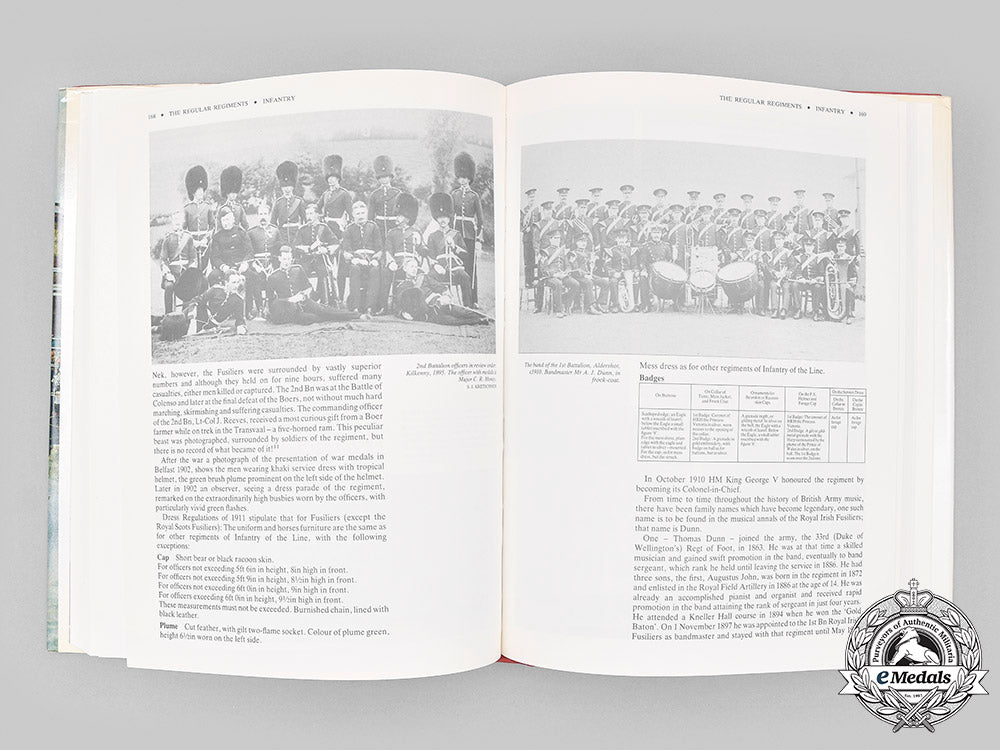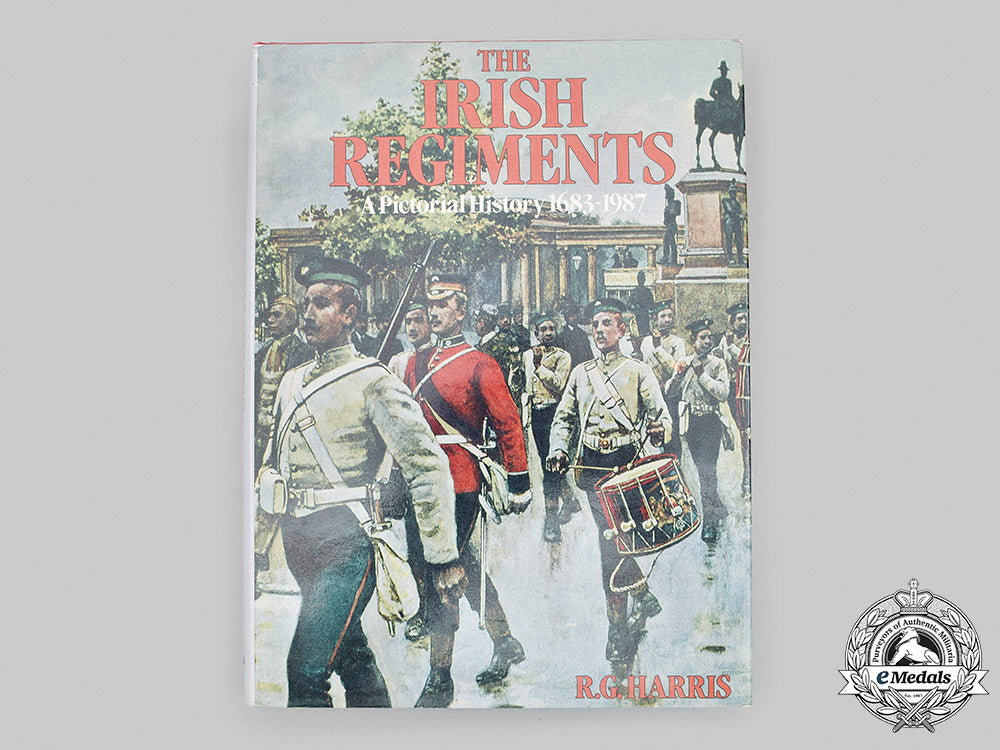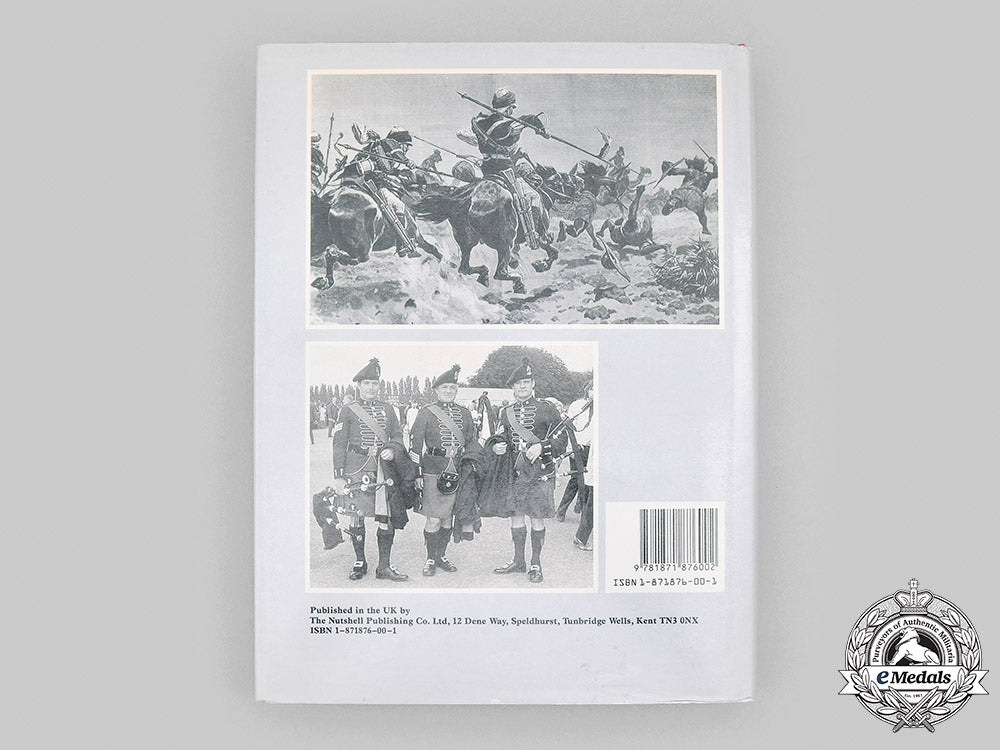
LOADING ...
In response to evolving domestic opinion, eMedals Inc has made the conscious decision to remove the presentation of German Third Reich historical artifacts from our online catalogue. For three decades, eMedals Inc has made an effort to preserve history in all its forms. As historians and researchers, we have managed sensitive articles and materials with the greatest of care and respect for their past and present social context. We acknowledge the growing sentiments put forth by the Canadian public and have taken proactive actions to address this opinion.



United Kingdom. The Irish Regiments - A Pictorial History 1683-1987
United Kingdom. The Irish Regiments - A Pictorial History 1683-1987
SKU: ITEM: GB7279
0% Buyer's Premium
Current Bid:
Your Max Bid:
Bid History:
Time Remaining:
Couldn't load pickup availability
Shipping Details
Shipping Details
eMedals offers rapid domestic and international shipping. Orders received prior to 12:00pm (EST) will be shipped on the same business day.* Orders placed on Canadian Federal holidays will be dispatched the subsequent business day. Courier tracking numbers are provided for all shipments. All items purchased from eMedals can be returned for a full monetary refund or merchandise credit, providing the criteria presented in our Terms & Conditions are met. *Please note that the addition of a COA may impact dispatch time.
Shipping Details
eMedals offers rapid domestic and international shipping. Orders received prior to 12:00pm (EST) will be shipped on the same business day.* Orders placed on Canadian Federal holidays will be dispatched the subsequent business day. Courier tracking numbers are provided for all shipments. All items purchased from eMedals can be returned for a full monetary refund or merchandise credit, providing the criteria presented in our Terms & Conditions are met. *Please note that the addition of a COA may impact dispatch time.
Description
Description
Hardcover, red cloth cover, with dust jacket, entitled "The Irish Regiments - A Pictorial History 1683-1987" by R.G. Harris, first published in the United Kingdom in 1989 by The Nutshell Publishing Co. Ltd. of Tunbridge Wells, Kent, printed in Great Britain by Courier International Ltd. of Tiptree, Essex, ISBN 1-871876-00-1. The dust jacket sums up the history of the regiments, as well as giving a brief analysis and direction of the book: "On 12 June 1922 H.M. King George V, at a sad and solemn ceremony at Windsor Castle, received the Colours of five Southern Irish Infantry Regiments which were disbanded that day, and made the following promise: 'I pledge my word that within these ancient and historic walls your Colours will be treasured, honoured, and protected as hallowed memorials of the glorious deeds of brave and loyal regiments.' (The South Irish Horse, possessing no Colour or Standards, presented a regimental engraving on the same occasion). It took another fifty years however for these regiments ro completely disappear. It was an Ulsterman, Field Marshal Sir Gerald Templer, who took the salute at a Whitehall parade in June 1972, the 50th Anniversary of disbandment when as one soldier explained 'We thought we would call it a day while we were still hale and hearty.' The Irish Cavalry fared marginally better by reduction to squadron strength and amalgamation with English regiments, whilst several English Cavalry Regiments shared the same fate at the same time. The Irish exception, to retain its single identity for another thirty years or so, was the 8th (King's Royal Irish) Hussars. The loss of these regiments was felt throughout the British Army, especially when one considers that for nearly 300 years a large proportion of its men were Irish, possibly as many as one-third. A statistic from World War I tells us that half-a-million Irishmen served in the British Army, representing about an eighth of the population of Ireland. Furthermore, about one-third of Britain's Field Marshals have come from Ireland, and of the ten Field Marshals of World War II, one-half had Irish origins. Fortunately the British Army that served this country so well during World War II had some fine Northern Irish Regiments remaining - as it has today although, once again after a war, more reductions and amalgamations took place. Irish Regimental historians have compiled several individual histories, in some instances substantial two-and-three-volume works - but one may have difficulty in finding these books today. It does seem strange however that as far as is known, the collective story of all the Irish Regiments, past and present, has not been forthcoming. This book will now fill this gap and, together with the numerous fine illustrations will show the Irish soldier in the British Army of the past 300 years, during peace and at war, at home and abroad." The book begins with a Table of Contents, followed by a Foreword by General Sir Brian Kenny KCB CBE - Commander-in-Chief of the British Army of the Rhine, an Author's Note and Acknowledgements. It is divided into four parts: Part 1 - Early and Disbanded Regiments (Cavalry and Fencibles, Infantry, Yeomanry, Volunteers, Royal Irish Artillery); Part 2 - The Regular Regiments - Cavalry (4th (Irish Irish) Dragoons Guards 47th-7th RDG, 5th (Royal Irish) Lancers 16th/5th QRL, 6th (Inniskilling) Dragoons 5th RIDG, 8th (King's Royal Irish) Hussars QRIH) and The Regular Regiments - Infantry (Irish Guards, The Royal Irish Regiment, The Royal Inniskilling Fusiliers, The Royal Irish Rifles, Princess Victoria's (Royal Irish Fusiliers), The Royal Irish Rangers, The Connaught Rangers, The Princess of Wales's Leinster Regiment (Royal Canadians), The Royal Munster Fusiliers, The Royal Dublin Fusiliers); Part 3 - Yeomanry, Special Reserve and Territorial Force (The Imperial Yeomanry, North Irish Horse, South Irish Horse, London Irish, Tyneside Irish, Liverpool Irish, Ulster Defence Regiment); Part 4 - Royal Artillery - The Militia and Volunteer and Support Units (Royal Artillery and Militia Artillery, The Irish Militia Regiments, Volunteer Support Units). It concludes with a List of Garrisons and Barracks in Ireland, a Bibliography and an Index. The book contains 288 pages, the text and majority of the photographs printed in black ink, with eight pages of colour plates inserted between pages 160 and 161, on a thick white paper stock, measuring 207 mm (w) x 278 mm (h) x 25 mm (d). Near extremely fine.
Reference Guide Shipping Policy: An additional shipping charge may be applicable following the time of purchase due to size, weight, and quantity. Please note that books cannot be shipped via Canada Post Flat Tracked method.
Description
Hardcover, red cloth cover, with dust jacket, entitled "The Irish Regiments - A Pictorial History 1683-1987" by R.G. Harris, first published in the United Kingdom in 1989 by The Nutshell Publishing Co. Ltd. of Tunbridge Wells, Kent, printed in Great Britain by Courier International Ltd. of Tiptree, Essex, ISBN 1-871876-00-1. The dust jacket sums up the history of the regiments, as well as giving a brief analysis and direction of the book: "On 12 June 1922 H.M. King George V, at a sad and solemn ceremony at Windsor Castle, received the Colours of five Southern Irish Infantry Regiments which were disbanded that day, and made the following promise: 'I pledge my word that within these ancient and historic walls your Colours will be treasured, honoured, and protected as hallowed memorials of the glorious deeds of brave and loyal regiments.' (The South Irish Horse, possessing no Colour or Standards, presented a regimental engraving on the same occasion). It took another fifty years however for these regiments ro completely disappear. It was an Ulsterman, Field Marshal Sir Gerald Templer, who took the salute at a Whitehall parade in June 1972, the 50th Anniversary of disbandment when as one soldier explained 'We thought we would call it a day while we were still hale and hearty.' The Irish Cavalry fared marginally better by reduction to squadron strength and amalgamation with English regiments, whilst several English Cavalry Regiments shared the same fate at the same time. The Irish exception, to retain its single identity for another thirty years or so, was the 8th (King's Royal Irish) Hussars. The loss of these regiments was felt throughout the British Army, especially when one considers that for nearly 300 years a large proportion of its men were Irish, possibly as many as one-third. A statistic from World War I tells us that half-a-million Irishmen served in the British Army, representing about an eighth of the population of Ireland. Furthermore, about one-third of Britain's Field Marshals have come from Ireland, and of the ten Field Marshals of World War II, one-half had Irish origins. Fortunately the British Army that served this country so well during World War II had some fine Northern Irish Regiments remaining - as it has today although, once again after a war, more reductions and amalgamations took place. Irish Regimental historians have compiled several individual histories, in some instances substantial two-and-three-volume works - but one may have difficulty in finding these books today. It does seem strange however that as far as is known, the collective story of all the Irish Regiments, past and present, has not been forthcoming. This book will now fill this gap and, together with the numerous fine illustrations will show the Irish soldier in the British Army of the past 300 years, during peace and at war, at home and abroad." The book begins with a Table of Contents, followed by a Foreword by General Sir Brian Kenny KCB CBE - Commander-in-Chief of the British Army of the Rhine, an Author's Note and Acknowledgements. It is divided into four parts: Part 1 - Early and Disbanded Regiments (Cavalry and Fencibles, Infantry, Yeomanry, Volunteers, Royal Irish Artillery); Part 2 - The Regular Regiments - Cavalry (4th (Irish Irish) Dragoons Guards 47th-7th RDG, 5th (Royal Irish) Lancers 16th/5th QRL, 6th (Inniskilling) Dragoons 5th RIDG, 8th (King's Royal Irish) Hussars QRIH) and The Regular Regiments - Infantry (Irish Guards, The Royal Irish Regiment, The Royal Inniskilling Fusiliers, The Royal Irish Rifles, Princess Victoria's (Royal Irish Fusiliers), The Royal Irish Rangers, The Connaught Rangers, The Princess of Wales's Leinster Regiment (Royal Canadians), The Royal Munster Fusiliers, The Royal Dublin Fusiliers); Part 3 - Yeomanry, Special Reserve and Territorial Force (The Imperial Yeomanry, North Irish Horse, South Irish Horse, London Irish, Tyneside Irish, Liverpool Irish, Ulster Defence Regiment); Part 4 - Royal Artillery - The Militia and Volunteer and Support Units (Royal Artillery and Militia Artillery, The Irish Militia Regiments, Volunteer Support Units). It concludes with a List of Garrisons and Barracks in Ireland, a Bibliography and an Index. The book contains 288 pages, the text and majority of the photographs printed in black ink, with eight pages of colour plates inserted between pages 160 and 161, on a thick white paper stock, measuring 207 mm (w) x 278 mm (h) x 25 mm (d). Near extremely fine.
Reference Guide Shipping Policy: An additional shipping charge may be applicable following the time of purchase due to size, weight, and quantity. Please note that books cannot be shipped via Canada Post Flat Tracked method.



You May Also Like
Russia, Imperial. An Order of St. Vladimir, IV Class in Gold, Military Division, c.1905
EU24277
Yugoslavia, Kingdom. An Order Of St. Sava, Knight Commander Cross, By Huguenin, c.1935
EU24276
Serbia, Kingdom. An Order Of Saint Sava, Breast Star
EU24275
Serbia, Kingdom. An Austrian-Made Order of St. Sava, Type II, Grand Cross c.1905
EU24274
Russia, Imperial. An Order of St. Vladimir, IV Class in Gold, Civil Division, c.1830
EU24273
-
Russia, Imperial. An Order of St. Vladimir, IV Class in Gold, Military Division, c.1905
EU24277
Add to CartRegular price $3,450 USDRegular price $0 USD Sale price $3,450 USDUnit price / per -
Yugoslavia, Kingdom. An Order Of St. Sava, Knight Commander Cross, By Huguenin, c.1935
EU24276
Add to CartRegular price $425 USDRegular price $0 USD Sale price $425 USDUnit price / per -
Serbia, Kingdom. An Order Of Saint Sava, Breast Star
EU24275
Add to CartRegular price $850 USDRegular price $0 USD Sale price $850 USDUnit price / per -
Serbia, Kingdom. An Austrian-Made Order of St. Sava, Type II, Grand Cross c.1905
EU24274
Add to CartRegular price $850 USDRegular price $0 USD Sale price $850 USDUnit price / per -
Russia, Imperial. An Order of St. Vladimir, IV Class in Gold, Civil Division, c.1830
EU24273
Add to CartRegular price $2,850 USDRegular price $0 USD Sale price $2,850 USDUnit price / per
Do you have a similar item you are interested in selling?
Please complete the form and our client care representatives will contact you.
Sell Item










